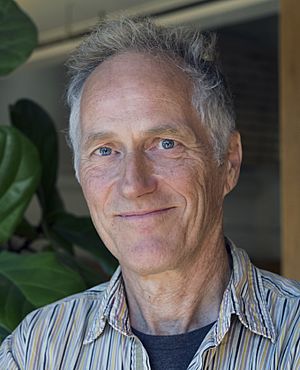Tim O'Reilly facts for kids
Quick facts for kids
Tim O'Reilly
|
|
|---|---|

O'Reilly in 2017
|
|
| Born |
Timothy O'Reilly
6 June 1954 Cork, Ireland
|
| Alma mater | Harvard University (AB) |
| Employer | O'Reilly Media |
| Board member of | Safari Books Online Maker Media PeerJ Macromedia MySQL AB Code for America |
| Spouse(s) |
Christina O'Reilly
(m. 1974)Jennifer Pahlka
(m. 2015) |
| Children | 2 |
Timothy O'Reilly (born June 6, 1954) is a famous author and the founder of the company O'Reilly Media. He is known for helping make the terms open source and Web 2.0 popular. These ideas have changed how we use computers and the internet.
Contents
Early Life and Schooling
Tim O'Reilly was born in County Cork, Ireland. When he was a baby, his family moved to San Francisco, California. He grew up with three brothers and three sisters. As a teenager, his older brother Sean encouraged him to read the works of a writer named George Simon. This introduced Tim to new ways of thinking that he found very interesting.
In 1973, he started studying classics (the study of ancient Greece and Rome) at Harvard University. He did very well in his studies and graduated in 1975 with a Bachelor of Arts degree.
Career in Technology
After college, O'Reilly began his career as a technical writer in 1977. This means he wrote instructions and guides to help people understand technology.
Starting O'Reilly Media
In 1983, he started his own business publishing computer manuals. He worked out of a small converted barn in Newton, Massachusetts. In 1989, he moved his company to Sebastopol, California.
A few years later, in 1992, his company published the Whole Internet User's Guide and Catalog. This book became a bestseller because it helped many people learn how to use the internet. His company, then called O'Reilly & Associates, grew quickly during the 1990s. It started by printing books and later moved into online publishing.
In 1993, the company created one of the first web portals, called the Global Network Navigator. A web portal is a website that brings together information from different sources. It was sold to America Online in 1995.
Investing in New Companies
O'Reilly is also a venture capitalist, which means he invests money in new companies to help them grow. He has invested in well-known companies like Blogger, Foursquare, and Bitly. He has also served on the boards of many technology companies and non-profit organizations, like Code for America.
Big Ideas and Contributions
Tim O'Reilly is known for more than just his company. He has helped shape some of the most important ideas in the world of technology.
What is Open Source?
In 1998, O'Reilly helped promote the term open source. Open source software is computer code that is free for anyone to see, use, and share. This is different from most software, where the code is kept secret by the company that made it.
O'Reilly believes open source is a key part of the internet. Many important internet technologies, like Linux and Apache, are open source. He worries about companies trying to create new ways to "lock in" users to their products.
What is Web 2.0?
After the dot-com crash in 2000, when many internet companies failed, O'Reilly wanted to bring back excitement to the tech world. In 2003, his company started using the phrase Web 2.0.
Web 2.0 describes a new version of the internet that is more interactive. Instead of just reading information, users could create and share their own content. Think of websites like YouTube, Wikipedia, and social media. These are all examples of Web 2.0, where the "collective intelligence" (or shared knowledge) of many people creates value.
Government as a Platform
O'Reilly also introduced the idea of "government as a platform," or "Gov 2.0." He believes governments can use technology and open data to work better. By sharing information openly, governments can be more efficient and solve problems more effectively, much like a technology platform.
Personal Life
After graduating from Harvard, O'Reilly married his first wife, Christina. They have two daughters, Arwen and Meara.
On April 11, 2015, O'Reilly married Jennifer Pahlka. She is the founder of Code for America and once worked as a technology advisor for the U.S. government.
See also
 In Spanish: Tim O'Reilly para niños
In Spanish: Tim O'Reilly para niños

